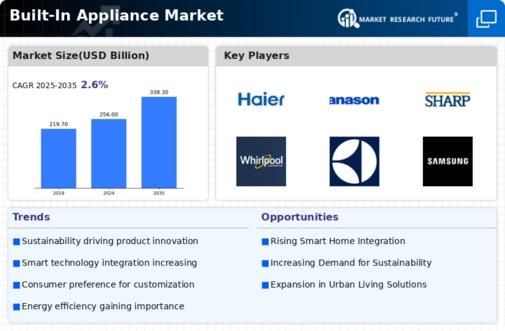Rising Urbanization
The Global Built-In Appliance Market Industry experiences a notable boost due to increasing urbanization. As more individuals migrate to urban areas, the demand for space-efficient and aesthetically pleasing appliances rises. Urban dwellers often seek built-in solutions that maximize limited space while providing modern conveniences. This trend is particularly evident in densely populated cities where real estate is at a premium. The market is projected to reach 256.0 USD Billion in 2024, reflecting the growing preference for integrated appliances that complement contemporary living spaces. Urbanization not only drives demand but also influences design trends, pushing manufacturers to innovate in the built-in appliance sector.
Sustainability Trends
Sustainability trends are becoming a driving force in the Global Built-In Appliance Market Industry. Consumers are increasingly aware of their environmental impact and are opting for energy-efficient appliances that reduce energy consumption and carbon footprints. This shift is prompting manufacturers to invest in eco-friendly technologies and materials, aligning their products with sustainable practices. For example, appliances that meet Energy Star ratings or utilize recyclable materials are gaining popularity. As sustainability becomes a key purchasing criterion, the market is expected to grow at a CAGR of 2.57% from 2025 to 2035, reflecting the increasing demand for environmentally responsible built-in solutions.
Market Growth Projections
The Global Built-In Appliance Market Industry is projected to experience substantial growth in the coming years. With an estimated market value of 256.0 USD Billion in 2024, the industry is expected to reach 338.3 USD Billion by 2035. This growth trajectory indicates a robust demand for built-in appliances, driven by factors such as urbanization, technological advancements, and changing consumer preferences. The market is anticipated to grow at a CAGR of 2.57% from 2025 to 2035, reflecting the ongoing evolution of consumer needs and the industry's response to emerging trends. These projections underscore the potential for innovation and expansion within the built-in appliance sector.
Growing Real Estate Sector
The Global Built-In Appliance Market Industry benefits from the expansion of the real estate sector, particularly in emerging economies. As new residential and commercial properties are developed, there is a corresponding increase in demand for built-in appliances that enhance functionality and appeal. Developers often incorporate modern built-in solutions to attract buyers and tenants, recognizing their value in contemporary living environments. This trend is particularly pronounced in regions experiencing rapid urban development, where the integration of built-in appliances is seen as a selling point. The growth of the real estate sector is likely to contribute to the overall expansion of the built-in appliance market.
Technological Advancements
Technological advancements play a crucial role in shaping the Global Built-In Appliance Market Industry. Innovations such as smart home integration, energy efficiency, and enhanced functionality are increasingly appealing to consumers. For instance, appliances that can be controlled remotely via smartphones or those equipped with energy-saving features are gaining traction. These advancements not only improve user experience but also align with sustainability goals, which are becoming more prominent among consumers. As the market evolves, the integration of artificial intelligence and IoT in built-in appliances is likely to enhance their appeal, potentially driving the market to an estimated 338.3 USD Billion by 2035.
Consumer Preference for Aesthetics
The Global Built-In Appliance Market Industry is significantly influenced by consumer preferences for aesthetics and design. Homeowners increasingly prioritize the visual appeal of their kitchens and living spaces, leading to a surge in demand for built-in appliances that seamlessly blend with cabinetry and interior decor. This trend is particularly strong among millennials and Gen Z, who often seek modern, sleek designs that enhance the overall ambiance of their homes. As a result, manufacturers are focusing on creating customizable options that cater to diverse tastes, thereby expanding their market reach. This shift in consumer behavior is likely to sustain growth in the industry over the coming years.














